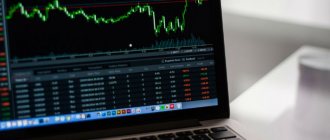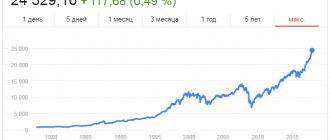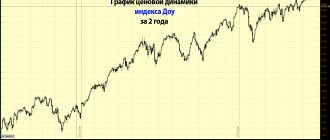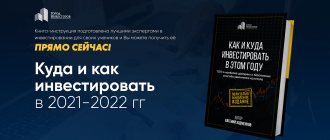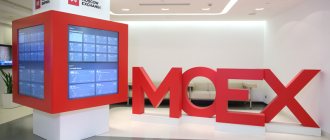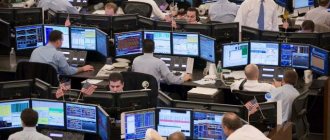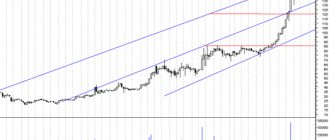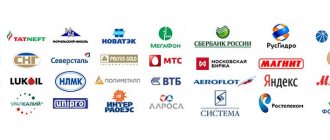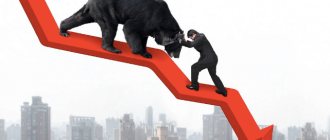Investor's Dictionary
Stock index
— an indicator that determines the movement of the securities market and reflects the dynamics of the average price of shares of a number of companies.
Dow Jones Industrial Average (DJIA)
- the first stock index, developed in 1896 by Charles Dow. Includes securities of 30 largest US companies.
S&P 500 Index
is one of the main US stock indexes, which includes about 500 large capitalization companies whose securities are traded on American markets.
Nasdaq Composite Index
is a composite index of the Nasdaq exchange, which includes more than 3,000 companies, about half of which are from the high technology sector.
"Weighted average capitalization" method
- a method of calculating an index, according to which companies with higher market capitalization have a greater influence on the index value.
ETF (Exchange Traded Fund)
- an exchange-traded investment fund, which includes shares of various companies. As a rule, these are securities included in some index.
What are stock indices
A stock index is an indicator that determines the movement of the securities market and reflects the dynamics of changes in the average price of shares of a number of companies. This is a basket of securities, the average “cost” of which is the index.
Each country has its own stock indices. In Russia, for example, the most famous are the RTS and the Moscow Exchange index, in Germany - the DAX30, in China - the SSE.
There are more than 2000 indices in the world. Indexes are created and managed by so-called providers. These may be exchanges, independent agencies, investment banks or large aggregators of financial information. For example, the American rating agency Standard & Poor's, which developed the S&P500 index, or the Nasdaq exchange. The latter is the founder of the Nasdaq indices, which unite companies from various industries.
Source: analytical service of GPB Investments
National indices reflect the situation on the stock market of a particular country. In the UK, the most famous is the FTSE index, in Germany - the DAX business activity index, in France - the CAC-40 index, in Japan - the Nikkei index.
Quotes of world financial indices. Source: investing.com
Each index has its own calculation formula, the frequency of review of the stocks included in it, and the rules by which they can be included in this list. Index values are published daily by the exchanges themselves and the most authoritative media: Wall Street Journal, Bloomberg, Reuters.
What types of indices are there on the stock exchange?
All stock indices are divided into two large groups: sectoral and composite. As you might guess, industry indices take into account securities of a specific selected industry: IT, oil and gas business, transport, food industry, and so on. Composite indices are made up of securities belonging to different industries. Using composite indices, you can assess the state of the economy of an individual country or the market as a whole.
Sometimes you may come across the following classification of stock indices:
- By instruments. For example, indices may include only stocks, only bonds, and so on.
- By geography. Indices can reflect the economies of individual states (national indices) or demonstrate the state of the world market (international indices).
- According to the calculation method. You may have already read above that the index is usually the average of the prices of assets from the sample. To be more precise, most indices are calculated using one of four formulas: unweighted arithmetic mean, weighted arithmetic mean (the method is also divided into groups according to the method of weighing), unweighted geometric mean, weighted geometric mean. Below you will see that all indices are calculated using their own special formulas, but they are based on the above calculations of averages.
How did stock indices appear?
The first stock index DJIA - Dow Jones Industrial Average - was developed in 1896 in the United States by Wall Street Journal journalist and famous financier Charles Dow. He helped monitor the market on a daily basis. Now this index is considered one of the main ones in the US stock market. Currently, it includes marketable securities of 30 largest American companies such as American Express, Apple, IBM, the so-called “blue chips”. It is calculated by taking the sum of all stock prices divided by the Dow Adjustment Factor.
But since 30 companies, even the largest ones, cannot fully reflect the state of the market, other indices have appeared that include a larger number of companies and are based on a different calculation algorithm.
Blue Chip Index (MOEXBC)
MOEXBC includes the 15 most liquid shares of the Russian market - “blue chips” . The indicator of this sector of Russian shares reflects investor confidence in the flagships of the domestic economy - LUKOIL, Sberbank, Gazprom, Norilsk Nickel, NOVATEK, Rosneft, Tatneft, etc. The indicator has been calculated since 2009, starting at 6285.76 points, by October 2022 the indicator is at the level 18,411.55 points. The capitalization of this index reaches 8,729,749,920,462 rubles.
S&P 500: index features
Another equally well-known index is the S&P 500. It gets its name from the financial rating agency Standard & Poor's, which manages it. This index was created in 1926 and initially consisted of 90 stocks, and only in 1957 its composition expanded to 500 stocks that are traded on US stock exchanges. It covers about 10 economic sectors. The largest share is occupied by high technology, medicine and finance.
The S&P 500 is calculated using the “weighted average capitalization” method—large capitalization companies have the greatest influence on the index value. The list of companies included in its calculation is revised 4 times a year.
It is this index that is most closely followed by fund managers and various financial players. Even at a global level, the S&P500 is considered a benchmark because it brings together a large number of companies that act as a “barometer” of the global economy. Its basic initial value is 10 points. Currently it is over 4000 points.
Source: wallstreetjournal.com
A point is a single change from the most recently published figure for an indicator. That is, there are no smaller deviations for this parameter. Points measure fluctuations in prices, currencies and securities quotes. For example, if the price of a security increases from 10 to 10.25, it is said to have increased by 25 points.
Nasdaq: several leading indexes
Nasdaq, another key index of the global economy, was created in 1971 by the National Association of Securities Dealers Automated Quotations. In fact, this is not one, but several indices, each of which reflects certain sectors of the economy. For example, Nasdaq Industrial shows the dynamics of industrial companies, and Nasdaq Bank shows the dynamics of bank holding companies.
The Nasdaq Composite Index, which covers more than 3,000 stocks, is the main one. This is what they mean when they talk about NASDAQ. While the index is known for having about half of its constituent companies as high-tech companies, it also consists of stocks from the financial, industrials, and biotech sectors. It includes not only companies from the United States, but also from other countries. The main condition is that their securities be traded on the Nasdaq exchange.
The Nasdaq Composite Index is calculated using a “moving average”: the sum of shares is multiplied by their closing price and then divided by the number of companies. Because the Nasdaq contains many high-growth startups, it is revised more often than the S&P 500. Despite their differences, these indices are highly correlated with each other, given that they contain many of the same companies and are influenced by common macroeconomic factors.
Composition of the Nasdaq Composite Index by industry. Source: analytical department of GPB Investments LLC
RTS and Moscow Exchange Index
We sorted that out and moved on.
Let's look at our most important indices - the RTS and the Moscow Exchange.
RTS Index
The abbreviation RTS stands for Russian Trading System.
The index was “born” on September 1, 1995. The starting value was 100 points. Initially it included 30 papers.
Over time, the composition (as well as the share) constantly changed. For a long time, RTS included 50 companies.
At the time of writing, the index had shrunk to 42 companies.
A few basic rules for the RTS index:
- values are updated every second;
- the composition is reviewed every quarter (on the third Friday of March, June, September and October);
- the weight of one paper is no more than 15%;
- no more than 55% for 5 papers.
Below is the current list of companies included in the index. Their shares, number of shares outstanding, Free-float and capitalization.
RTS Index Composition
Considering that changes occur every 3 months, do not rely too much on the above table. Even if companies don't change, the weights definitely change every quarter.
The current composition of the RTS index can be viewed on the Moscow Exchange website.
Please note that the weight of only 3 companies (Gazprom, Lukoil and Sberbank) in the index is more than 41%. The remaining 39 companies have to share the remaining 60% of the index among all.
Quotes from the Big Three have a huge impact on changes in the index. A price drop (by just a couple of percent) can pull the entire index into the red zone. Even if most other companies will not fall.
The opposite situation: a significant increase in some security from the index with a small weight.
For example, VTB. Even if quotes soar by 20% in a day, the index won’t even notice it. Considering the bank's share of the weight is just over 1%, VTB's twenty percent growth will result in an overall change of only 0.2%.
Moscow Exchange Index or IMOEX
The brother (I meant to say twin) of the RTS index. But the younger one.
Started a couple of years later. September 27, 1997. Also from a hundred points.
The principles of calculation, frequency of composition review and selection criteria are similar to RTS.
Damn, even the composition is the same. I will not provide a table of papers with IMOEX weights. Here is a link again to the exchange website for the index. Find the difference.
Until 2022, IMOEX bore the proud name of MICEX. Then it was renamed the Moscow Exchange index.
Just for general information. How does MICEX stand for? Moscow Interbank Currency Exchange.
S&P 500 and Nasdaq: based on what principles companies are included
The S&P500 index includes such American giant companies as Apple, Microsoft, Amazon, Facebook, Aphabet. The main criterion is the volume of market capitalization, which must be at least 6.5 billion US dollars per company. It must be kept in mind that not all of the largest US companies can get into the S&P 500. If companies have insufficient liquidity, that is, do not reach the minimum trading volume of 250,000 shares per month, and also if the company is privately owned, then it will be included in the index can not.
The selection parameters are designed so that the list includes companies from different sectors of the economy, but at the same time they have different “weights” in the index. For example, the 5 largest companies in the S&P 500 stock market index weigh the same as the 350 smaller ones.
Unlike the S&P 500, the Nasdaq has more relaxed selection criteria. This index includes more than 3,000 companies from around the world whose shares are traded on the Nasdaq exchange. The top 5 are Apple, Microsoft, Amazon, Facebook, Alphabet. Almost half of the index is occupied by the new technologies sector, which includes companies such as Tesla, Superconductor Technologies, Silicon Laboratories, National Research Corporation, etc.
To become a member of the index, companies must:
- have shares with a trading volume of at least 250 thousand per month;
- not be in bankruptcy proceedings;
- Submit quarterly and annual reports regularly.
These are only minimum requirements, compliance with which does not always guarantee inclusion in the index.
Russian
Stock indices are international and national. Russian ones are those that include companies operating in the country.
The most important stock indices in Russia:
- RTS is an index of the leading Moscow Exchange. Among the shares included in the index, only the largest, developing Russian companies that are traded on the mentioned exchange are noted. The RTS is based on share prices displayed in US dollars.
- Moscow Exchange Index - previously it was the MICEX, but after the merger of the RTS and the MICEX took place under the auspices of the Moscow Exchange, the name was changed. Includes 50 shares of companies that form the basis of all sectors of the Russian economy. The list of companies is reviewed every 3 months.
- Blue chip index - also calculated on the Moscow Exchange, includes shares of blue chip companies on the market (the largest, most influential).
- MSCI Russia - the indicator is calculated by the international company MSCI inc (as well as for other countries with developing economies). The index includes Russian companies selected on the basis of capitalization, the number of shares in free circulation, and their availability to investors from abroad. The index is calculated in US dollars, the list of companies is updated every 3 months.
How to use indexes correctly
A stock index helps assess market conditions and serves as a benchmark for measuring the difference between portfolio returns and financial market returns.
The index helps to understand the general trend: in which direction the market is moving - whether stock prices are rising or falling. It helps investors identify the most promising and growing industries and market segments.
Indexes are good indicators for determining the performance of investments compared to market averages. For example, investing in funds that copy the S&P500 index gives an average return of 8-10% per annum in dollars. This is the average level of return that many investors focus on when forming investment expectations. Active investors often try to beat the market, including using high-risk instruments, in order to get even greater returns on investments.
Is it worth building a portfolio of index stocks?
The securities included in the index are considered a reliable and liquid asset. That is why it is used not only by experienced investors, but also by those who have recently started trading on the stock exchange and are not ready to use riskier financial instruments.
Assembling a portfolio of shares so as to completely replicate the structure of the index, or at least the companies included in its “top”, is difficult and expensive. Instead, you can invest in an ETF or mutual fund. Its essence is to immediately buy part of the shares of various companies. Read more about how they work in the article “What are investment funds and how do they work.”
Risks of Using Indexes
The S&P 500 and Nasdaq indices are constructed using the so-called “capitalization” method. This method involves giving more weight to companies with large market capitalizations compared to companies with smaller market capitalizations. In the S&P 500 stock market index, the largest companies - Apple, Microsoft, Amazon, Aphabet and Facebook - weigh the same as the 350 smaller ones. This means that even a small drawdown in Apple, Google or Microsoft will greatly affect the index value. And if the shares of other companies increase 2-3 times, it will be almost unnoticeable.
Risks are distributed unevenly among different companies and are concentrated on a minority of them. This throws the index out of balance and makes it extremely sensitive to fluctuations in the prices of certain stocks.
The risks of the Nasdaq Composite index are that the composition of companies is too heterogeneous: from time-tested companies to IT startups. It is almost impossible to track the emergence of the next Internet bubble. The history of the index speaks volumes about this. From 1994 to 2000, the dot-com bubble formed on the stock exchange, and the Nasdaq Composite soared to a record high of 5132.52 points. March 10, 2002, and five days later it collapsed sharply. Return to a value of more than 5000 pp. the index was able only 13 years later, in July 2015.
Valuation of the Nasdaq Composite Index during the dot-com bubble. Source: investing.com
There are now about 2,000 different indices in the stock market, and one way to diversify your investment portfolio is to buy a stake in an investment fund that tracks one of the leading indices. Shares of such funds can be sold on the stock exchange in the same way as ordinary shares. This option may be suitable for long-term investors - over a 10-15 year horizon, such funds can show growth of about 10% per annum.
